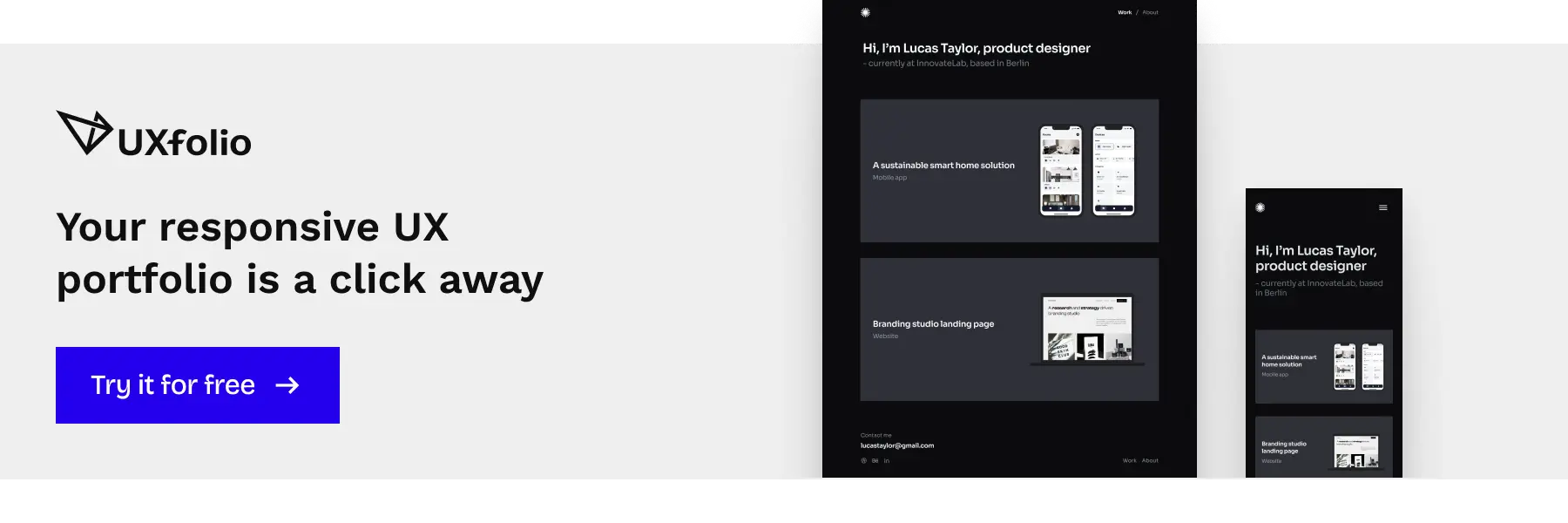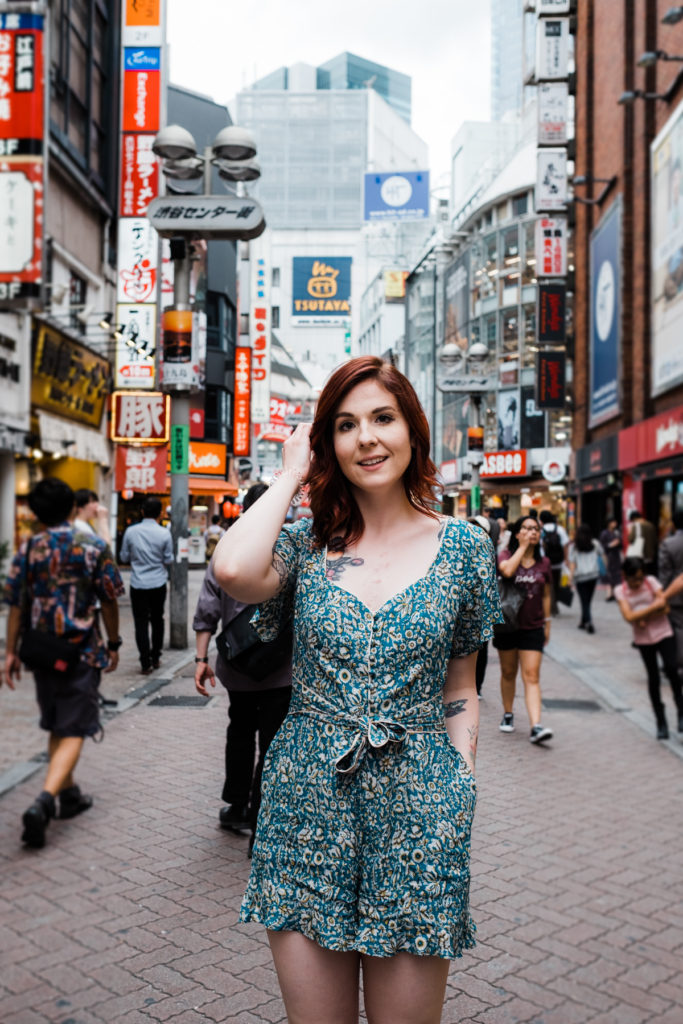Camille Gribbons, UX designer at Booking.com, discusses her career in a most engaging way. It might be due to her musical theater background, or her enthusiasm for the profession, or the fact that she is super relatable and down-to-earth. Following her brilliant talk at AMUSE –“This Design Sucks” – we sat down to chat about topics such as becoming a UX designer, UX case studies, freelancing, coding as a UX designer, and mentorships. She shared some of the most realistic advice that could serve as a compass to anyone who aspires to become a UX designer.
Could you share some details about the beginning of your career? How did you end up in UX?
During university, I worked many different jobs, including retail and house-cleaning at a bed and breakfast. At one point, I found out about a get-rich-quick scheme online. It consisted of creating a niche website that would have a small but steady follower-base and selling things through affiliate links on the site.
I chose “The Bachelor” franchise as my niche subject since I am a huge fan myself. The plan was to create a website that collects all the gossip around the show, add affiliate links for products relevant to the audience, and start making money. At that point, I didn’t have any actual experience with website building or marketing, and jumped into teaching myself online.
In the end, I didn’t make any money or even get much traffic, but I realized how much I enjoyed making websites. This led me to enroll in online HTML and CSS classes and to switch my major at Arizona State University to web and graphic design, and later interactive design at the Queensland University of Technology in Brisbane, Australia.
Did you get to utilize your HTML and CSS skills at that point?
When I went to study abroad in Australia as part of a program through ASU, I arrived two months early and found that I couldn’t legally work in Australia until I started school. I was lucky enough to have a scholarship to get by and wanted to take the opportunity to get a head start on my career. I contacted various software companies and design agencies in Brisbane and offered to work for free for two months as an intern because I just wanted to learn and gain experience in the industry.
That is when I stumbled upon Vision6, an email marketing software company that employed me as an intern for two months. They ended up liking me, so they hired as a junior web designer me as soon as I could legally work. At Vision6 I was learning a lot from the in-house UX designer while working on their site, which consisted of HTML and CSS work (in addition to design). On the side, I was freelancing and building websites for a community of small business owners in Queensland, which also required HTML, CSS, and WordPress customization.
Meanwhile, a mentor of mine at Vision6 went on to work at Booking.com in Amsterdam. I had reached out to him, asking how he liked the new job and the city. He told me how much he enjoyed Amsterdam and offered to refer me to the company and I got in through their graduate program (a program that Booking.com had at the time for recent graduates). Being part of this program exposed me to many different parts of the business.
How did you end up working specifically on BookingLokal?
Once the program was over, I got a promotion to a core UX Designer role and I had to decide where in the company I wanted to go. At that time Booking was considering an initiative for emerging markets, focusing on Japan. Since I’m obsessed with Japan, I wanted to be on that project. I started thinking “Who do I talk to to get me on this project? Put me in coach, I’m ready, let’s do this.” I found the relevant people in charge and joined the team, which initially had a lot of different focuses, including Japan, Mexico, India, and Indonesia.
Later the company started the BookingLokal project from scratch. First, they created a very basic site and a small marketing campaign to measure interest. This was shaping up to be a bigger design project and an exciting new initiative, so I really wanted to work on it. I joined the original team and we began iterating on the first version of the site during a Hackathon project. It all continued to evolve from there and that’s how we reached the point where we are today.

BookingLokal is for the Indonesian market. In what ways did you have to alter your usual process because of the cultural differences?
The biggest exercise is stakeholder management, as the stakeholders are involved in every single step of my design process. From wireframes to flow – I present everything to the team in Indonesia, which includes the marketing team, social media experts, and the operations team as well. Even though they aren’t in “product roles”, they are locals and experts on the market, so their feedback is invaluable. Before putting anything into design, again, I get on a call and ask their feedback on everything and ask them to test the design, occasionally just within the team, but also with users
Overall, it becomes a much lengthier process which involves a lot of people from different fields. All that feedback has to be prioritized and balanced. Everyone has an opinion on design, right? Some of it is grounded in the knowledge of the market, some are purely subjective, such as “I don’t like this icon.” As a designer, you have to find the line between the two and prioritize accordingly.
How do you measure the success of your design at BookingLokal?
At first, it was really difficult because we didn’t have any users. Booking.com has millions of visitors – you make one small change on the site and you can immediately see the impact. But we didn’t have the quantitative data that we could use to see the effects of the design. Also, there are so many factors happening at once, so it is hard to measure whether one single change made a huge impact on conversion for example.
Therefore, in the beginning, it was all qualitative data, user testing, and user research. Before a design workshop, we conducted user research, market research, user interviews, and focus groups. For smaller features we did street testing, for larger features we coordinated with a user testing agency. When testing iterations with the agency, we did the whole setup with the double mirrors, observing people using the product, coming up with a research script and creating an entire research plan. Today, we have Google Analytics and a decent amount of traffic and users for quantitative data analysis. Still, the process is largely dependent on qualitative research.
What were the biggest challenges for you as the designer on this BookingLokal project? How did you tackle them?
Before this project, I never really had to consider business or development resources. Everyone was telling me, “Camille, you are the user experience expert, you design what’s best for the user and that’s all that matters.” Now there is a lot more to think about. How much time will it take to develop this? What is really necessary and what is unnecessary? What’s the business impact of this?
So, I now have to consider and understand the business aspect and the politics of the business too. If someone higher up wants something, you cannot just say “that’s stupid, we should user test first.” You have to back up every decision with user data, come back, and continue from there.
In your talk you shared an anecdote, in which it all came down to “this design sucks.” How do you deal with a situation like that?
The worst possible thing you could do is get defensive. You have to practice humility when it comes to a situation like this. If incorrect assumptions are made about our users or our market and we launch something that doesn’t work, you just have to own up to it and say , “Yeah, I messed up. Help me make it better.” That is the best you can do because it sends a positive message. The key stakeholders involved start to think, “Oh well she knows she messed up and she wants us to help her fix it” instead of “Oh she thinks she’s the best and won’t listen to us.”
Diffusion of responsibility is important as well, so everyone feels like they have a stake in the product and the designer can’t be the only person to blame if something doesn’t work. Everyone is involved, they have the chance to give feedback, test with users, etc. So, it all comes down to humility and getting everyone involved.
Based on your experience, what advice would you give someone who is considering to start out in UX?
I would advise a more generalist approach opposed to specialist. One pattern that I have seen is that at most places you’re expected to be a jack of all trades. Learn some beginner HTML and CSS, as well as the basic principles of graphic, interface, and UX design. You will have to dabble in all of these areas to make yourself marketable to companies. It is not about becoming an expert in all of these areas, but being exposed to them and knowing the very basics.
There’s not a universal definition of UX and that’s why I think if you are starting out, it is best to just try yourself out in all areas. Once you get into a company and you get to know and love a certain area, you can choose to specialize in that.

The question of coding comes up a lot in UX career discussion. As someone who knows how to code, do you think it is a considerable advantage to have this skill?
In my current job, I haven’t coded in the past year and a half, even though HTML and CSS skills are required when you interview for a designer job at Booking.com. I would highly recommend to get the basics down so you can get your foot in the door. As a freelancer, it is even more important, so you are at least able to custom style sites even if you use a site-building tool.
What do you think are the skills or soft skills that are needed to stay relevant or to do your job well in this industry?
One thing I mentioned earlier is understanding the business aspects and development-time aspects of a project. You have to work on product managerial skills as well, like being able to prioritize, being able to understand business impact, helping to create a design vision and a design roadmap.
I firmly believe that design should be a key part of strategy but that’s not really the case in many companies. So it is our job to make sure that it becomes an essential part of strategy. To do that you need to be able to marry this amazing user experience with making money for the company.
It is also important to be able to communicate with business people. Especially communicating the value of design and how it can be integrated as part of the strategy for a product. Be prepared for that.
What changing trends do you recognize in UX design and the overall approach to UX? Which areas or attitudes do you think could benefit from improvements?
I think the biggest trend is being a generalist because companies are expecting UXers to do everything. Identify the problem, find the solution, then design the solution and make it beautiful with graphics, icons, illustrations, and a nice interface… Ultimately, that requires a lot of skills, including user research, problem-solving, data analysis, flow building, interface design, graphic design, etc. It goes on and on, which is why dabbling into more skills will make you more marketable.
Because of a lack of understanding of the role, I believe UXers are currently delegated many joyless and mindless tasks, while they should focus on solving problems instead. I think this is a trend that could hopefully change in the future as the definition of the role evolves.

You keep a very detailed and informative online portfolio. In your opinion, what are the must-have elements of an impressive UX portfolio?
I would highly recommend quick and to the point case studies. Showing pretty screenshots is not going to cut it because recruiters look through hundreds of UX portfolios. They want to see what was your role, what you did, and the impact of your work. The sooner you learn to communicate those things in a succinct and impressive way, the better you’re going to be set up.
One of my mentors is the CEO of a startup in Silicon Valley. She said that the number one thing she looks for in a rockstar designer is the ability to dive into quantitative data, like Google Analytics. So if you can show that you are good with research, user testing, and other UX methods, as well as data analysis, you are good.
You worked as a freelancer before joining Booking.com. Could you share your thoughts on the pros and cons of working on smaller projects vs. working as a UX/product designer at a huge and renowned company?
Working for a company like Booking gives you much more structure and allows for a much better work-life balance. As a freelancer it is easy to blur the line between leisure and work. Whereas in a regular job you know your working hours; you go in, do your work and you leave.
At a big company, you are also more protected and you have way more perks. Nowadays, you get mental health leave on top of sick leave. Of course, this depends on the company too.
On the other hand, as a freelance designer you work alone on an entire product, which I love. Sometimes you can be in complete charge of branding, the UX and UI, which is very cool. Also, when I look at a site that I have done for a small business, it gives me a sense of pride and ownership.
At BookingLokal I get the best of both worlds. I’m employed by Booking.com, but I can own this app myself.
You have mentioned mentors more than once in your answers. Do you think having a mentor is an important element of becoming a successful UXer?
Yeah, I definitely recommend it. Just keep in mind that a mentorship is always driven by the mentee. I wouldn’t recommend mentorship for someone who thinks it’s just reaching out to a CEO asking, “Hey, will you mentor me?” and then expecting them to do something. It’s more about being super engaged and coming with questions as a mentee.
I contact my mentors when I have a very specific question that I know that they can answer and I can gain their knowledge on. It’s not a formal or structured mentorship program, but it’s good to have people on your side. It’s good to have people who know more and have already gone through what you are going through and are happy to share their learnings with you.
Were you actively seeking mentors or did it happen by chance?
Actively seeking. One of them came to speak at a conference at Booking. I thought she was such a badass so I sent her a message on LinkedIn saying “You are such a cool and inspiring role model for women in tech, and your talk at Booking stuck with me. Can we have a call some time, even just to chat about some career advice, maybe some sort of mentorship?” And she was like, “Yeah, awesome. Let’s have a call.” That was it.
You speak at design conferences, such as Amuse. How did these activities become part of your professional life? Why do you find them important?
I did a lot of musical theater growing up, so I love singing, dancing, and acting. I was a small local celebrity because I was in a lot of shows at the community theater and appeared in newspapers as promotions for the theater. So, I grew to love the stage very early on. There was a point in my life when I was like, “I’m going to be on Broadway and that’s the only thing I’m going to do with my life.”
Clearly, since I am now a UX designer, Broadway didn’t happen, but giving talks as a UX designer is a way for me to be on stage. It’s definitely more difficult to come up with my own content, because as an actress, singer, dancer, whatever, you’re usually performing what someone else wrote. Whereas now I write and put together everything myself. It’s a lot of work, but it’s very rewarding being on stage.
So, it stems from my love for the stage and channeling that into my professional life. On top of that, I get the rewarding experience of actually sharing what I am working on and my learnings as well as being inspired by others at these conferences.
Connect with Camille on LinkedIn by finding her at or check out her portfolio for more contact information.
Start creating your UX portfolio with UXfolio
With UXfolio you can focus on putting together expressive case studies that reveal the full extent of your skill. Make use of our UX-specific sections, text ideas, and guiding questions to create case studies that recruiters will love! You can easily present your process in a streamlined fashion, utilizing your wireframes, prototypes, and screens. Start building your UX designer portfolio today!